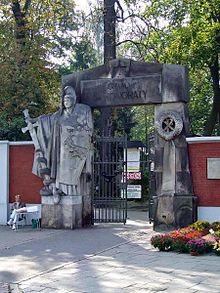- Powązki Cemetery
-
"Powązki" redirects here. For other uses, see Powązki (disambiguation).Not to be confused with Powązki Military Cemetery.
Powązki Cemetery 
Saint Honorata gateDetails Year established November 4, 1790[1] Country Poland Location Warsaw Type Public Size 106,25 acres (0,43 km²)[1] Number of graves over 1 million Website Unofficial website Find a Grave Powazki Cemetery Powązki Cemetery (Polish pronunciation: [pɔˈvɔ̃skʲi]; Polish: Cmentarz Powązkowski), also known as the Stare Powązki (English: Old Powązki) is a historic cemetery located in the Wola district, western part of Warsaw, Poland. It is the most famous cemetery in the city, and one of the oldest. Found here are the graves of many illustrious individuals from Polish history, including those interred along the "Avenue of Notables" (Aleja Zasłużonych) established in 1925.
The cemetery is often confused with the newer Powązki Military Cemetery, which is located to the north-west of the Powązki Cemetery.
Contents
Details
The Powązki Cemetery was established on 4 November 1790, it was consecrated on 20 May 1792 and initially covered the area of only about 2.5 ha. In the same year the Saint Karol Boromeusz Church, designed by Dominik Merlini, was built at the cemetery. The catacombs were also soon built.
Soon afterwards, several other cemeteries were founded in the area: Jewish, Calvinist, Lutheran, Caucasian and Tatar. The Orthodox cemetery is located not far from the Powązki necropolis.
Like many of the old European cemeteries, Powązki's tombstones were created by some of the most renowned sculptors of the age, Polish and foreign. Some of the monuments are excellent examples of various styles in art and architecture.
On All Saints Day (November 1) and Zaduszki (November 2) in Warsaw, vigils are held not only in the Roman Catholic cemeteries, but in the Protestant, Muslim, Jewish and Orthodox cemeteries as well. At Powązki Cemetery, all the graves are decorated with candles.
Selected notable burials
A few of the notables buried here are:
- Tekla Bądarzewska-Baranowska (1834–1861), composer
- Izabela Barcińska née Chopin (1811-1881), youngest sister of Fryderyk Chopin, composer.
- Wojciech Bogusławski (1757–1829), writer, actor, director
- Emilka Chopin (1812-1827), sister of Fryderick Chopin, composer.
- Ludwika Jędrzejewiczowa nee Chopin (1807-1855), oldest sister of Fryderyk Chopin, composer.
- Mikołaj Chopin (1771-1844), father of Fryderyk Chopin, composer.
- Justyna Chopin (d.1861), mother of Fryderyk Chopin, composer.
- Gerard Antoni Ciołek (1909–1966), architect and historian of gardens
- Ignacy Dobrzyński (1807–1867), composer
- Jerzy Duszyński (1917–1978), actor
- Józef Elsner (1769-1854), composer and conductor. Piano teacher of Fryderyk Chopin.
- Władysław Filipkowski (1892–1950), military commander
- Pola Gojawiczyńska (1896–1963), writer
- Józef Gosławski, (1908–1963), sculptor and medallic artist
- Leopold Janikowski (1855–1942), meteorologist, explorer and ethnographer
- Stanisław Janikowski (1891–1965), Polish diplomat
- Stefan Jaracz (1883–1945), actor
- Jan Kiepura (1902–1966), singer and actor
- Krzysztof Kieślowski (1941–1996), film director
- Jan Kiliński (1760–1819), freedom fighter
- Stefan Kisielewski (1911–1991), art critic and writer
- Krzysztof Komeda (1931–1969), jazz composer
- Henryk Kuna (1885–1945), sculptor
- Tadeusz Łomnicki (1927–1992), actor
- Witold Lutosławski (1913–1994), composer
- Witold Małcużyński (1914–1977), classical pianist
- Stefan Mazurkiewicz (1888–1945), co-founder of the Warsaw school of mathematics
- Stanisław Moniuszko (1819–1872), composer
- Antoni Osuchowski (1849–1928), philanthropist and national activist
- Lech Pijanowski (1928–1974), film-maker and game designer
- Bolesław Prus (1847–1912), journalist and novelist
- Kazimierz Pużak (1883–1950), died in the Communist prison, secretly buried in Powązki
- Władysław Reymont (1867–1925), Nobel Prize-winning novelist
- Irena Sendlerowa (1910–2008), head of Children's Section of the Żegota
- Wacław Sierpiński (1882–1969), mathematician
- Andrzej Sołtan (1897–1959), physicist
- Michał Karaszewicz-Tokarzewski (1893–1964), general
- Jerzy Waldorff (1910–1999), art critic and one of the benefactors of the Cemetery
- Henryk Wieniawski (1835–1870), composer
- Kazimierz Wierzyński (1894–1969), poet and writer
- Stanisław Wigura (1901–1932), aircraft designer and aviator
- Stanisław Wojciechowski (1869–1953), president of Poland
- Aleksander Zelwerowicz (1877–1955), actor and director, patron of the Warsaw Drama Academy
- Franciszek Żwirko (1895–1932), aviator
- Wojciech Żywny (1756-1842), first piano teacher of Fryderyk Chopin, composer.
Gallery
-
Saint Karol Boromeusz Church
-
Edward Rydz-Śmigły grave
References
- ^ a b "Historia Cmentarza Powązkowskiego" (in Polish). http://starepowazki.sowa.website.pl/Historia/historia.html. Retrieved 10 August 2010.
Coordinates: 52°15′07″N 20°58′22″E / 52.25194°N 20.97278°E
Categories:- Cemeteries in Warsaw
- Roman Catholic cemeteries
Wikimedia Foundation. 2010.





